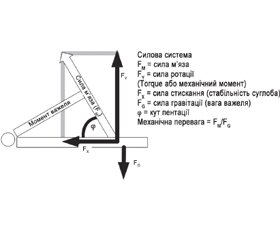Журнал «Травма» Том 24, №3, 2023
Вернуться к номеру
Вплив зміни довжини компонентів м’язово-сухожильного елемента м’язів колінного суглоба на його ізометричну силу та крутний момент
Авторы: Тяжелов О.А., Карпінська О.Д., Біцадзе М.З., Міхановський Д.О.
ДУ «Інститут патології хребта та суглобів ім. проф. М.І. Ситенка НАМН України», м. Харків, Україна
Рубрики: Травматология и ортопедия
Разделы: Клинические исследования
Версия для печати
Актуальність. Контрактура колінного суглоба, яка розвилася внаслідок іммобілізації після позасуглобових травм нижньої кінцівки, призводить до кульгавості, порушення ходьби, появи болю в інших суглобах нижніх кінцівок. Тривала іммобілізація суглоба призводить до послаблення та збільшення жорсткості м’язів, зміни довжини сухожилків та міофібрил м’язів, втрати амортизаційних властивостей хряща, гальмування процесів кровообігу періартикулярних тканин. Адекватна реабілітація й відновлення функції колінного суглоба після іммобілізації є медичною та соціальною проблемою щодо зменшення інвалідності. Мета роботи: вивчити вплив зміни сили, довжини м’язів та сухожилків колінного суглоба на крутний момент. Матеріали та методи. Для моделювання взята базова модель OpenSim Leg39.osim. Параметри м’язів та сухожилків були змінені відповідно до умов іммобілізації на 45 діб під кутом переважного утримання кінцівки 15°. Аналізували 3 моделі: базова модель без змін параметрів м’язів, модель зі зміною довжини м’язово-сухожильного елемента та модель зі зміною додатково сили м’язів (відповідно до розрахунків). Результати. Зміна довжини компонентів м’язово-сухожильного комплексу м’язів-згиначів мало впливає як на ізометричну силу м’язів, так і на крутні моменти колінного суглоба, які створюють ці м’язи. Зменшення максимальної ізометричної сили м’язів-згиначів призводить до зменшення крутного моменту. При зміні довжини м’язів-розгиначів спостерігається різке збільшення ізометричної сили та крутних моментів колінного суглоба та зміна напрямку траєкторії активного крутного моменту. Зменшення сили м’яза призводить до зменшення рівня крутних моментів з наближенням до норми, але напрямок залишається зміненим. Висновки. Математичне моделювання впливу зміни компонентів м’язово-сухожильних елементів м’язів, відповідальних за рух колінного суглоба, показало, що незначні зміни їх довжини призводять до помітних порушень як крутного моменту суглоба, так і змін ізометричної сили м’яза при рухах. Прогнозування зміни крутного моменту колінного суглоба може бути корисним при вивченні конкретних клінічних ситуацій при контрактурах внаслідок тривалого знерухомлення після позасуглобових травм. Але не може бути повністю перенесеним на практику через значну умовність параметрів моделей. Застосований метод моделювання може показати тенденції щодо зміни параметрів функціонування м’язів при зміні їх геометрії і може бути розширений для вивчення інших параметрів м’язів та суглоба.
Background. A knee contracture developed due to immobilization after extra-articular injuries leads to lameness, impaired walking, and the appearance of pain in other joints of the lower limb. Long-term immobilization of the joint leads to weakening and increasing stiffness of muscles, changes in the length of tendons and myofibrils, loss of cushioning properties of cartilage, inhibition of blood circulation processes in the periarticular tissues. Adequate rehabilitation and recovery of the knee joint function after immobilization is a medical and social problem in terms of reducing disability. The goal of the work: to study the influence of changes in strength, length of muscles and tendons of the knee joint on torque. Materials and methods. The OpenSim Leg39.osim base model was used for simulation. The parameters of the muscles and tendons were changed in accordance with the conditions of immobilization for 45 days at the angle of preferential position of the limb — 15°. Three models were analyzed: a basic model without changes in muscle parameters, a model with a change in the length of the muscle-tendon unit, and a model with an additional change in muscle strength (according to calculations). Results. Changing the length of the components of the muscle-tendon unit of the flexors has little effect on both the isometric strength of the muscles and the knee joint torques produced by these muscles. A decrease in the maximum isometric force of the flexor muscles leads to a decrease in torque. When the length of the extensors changes, there is a sharp increase in the isometric force and torques of the knee joint and a change in the direction of the active torque trajectory. A decrease in muscle strength leads to a decrease in the level of torques approaching normal, but the direction remains unchanged. Conclusions. Mathematical modeling of the effect of changes in the components of the muscle-tendon unit of the muscles responsible for the movement of the knee joint showed that minor alterations in their length lead to noticeable violations of both the torque of the joint and changes in the isometric strength of the muscle during movements. Predicting the change in knee joint torque can be useful in studying specific clinical situations with contractures caused by a long-term immobilization after extra-articular injuries. But it cannot be fully transferred into practice due to the significant conditionality of model parameters. The used modeling method can show trends in the change of muscle functioning parameters when changing their geometry, and can be extended to study of other muscle and joint parameters.
колінний суглоб; моделювання; контрактура; крутний момент
knee joint; modeling; contracture; torque

